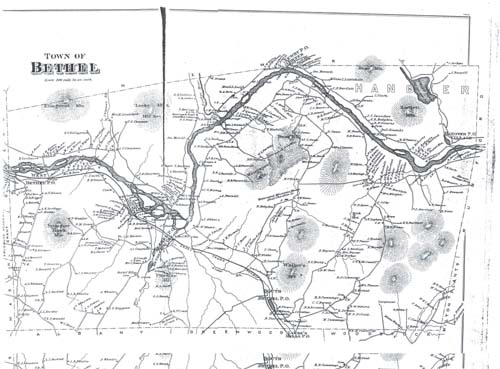Bethel: A Historic Town
| "Bethel: A Historic Town" is based on a current exhibit at the Bethel Historical Society's Regional History Center | |
| Introduction | |
| Situated
in the fertile Androscoggin
River valley surrounded by some of
the highest mountains in Maine, the town of Bethel traces its origins
to a 1768 grant made by the Commonwealth of Massachusetts to men whose
ancestors had fought in a campaign to conquer Canada in 1690.
Originally named "Sudbury Canada," in honor of these early grantees
from the town of Sudbury, Massachusetts, and their campaign against
Canada, Bethel was first settled by
people of European descent in 1774. Long before white settlement, Bethel was home to generations of Abenaki Indians. Their main village site here was located on the north bank of the Androscoggin River west of Riverside Cemetery. Thanks to the labors of Bethel's preeminent nineteenth century antiquarian and educator, Dr. Nathaniel Tuckerman True, we know something of the lives and times of Bethel's last Native inhabitants, including the legendary figure Molly Ockett, who died in 1816. The American War for Independence slowed the settlement of this region to such an extent that there were only ten families residing in Sudbury Canada at the time of "New England's Last Indian Raid" in 1781. Following the War, however, the movement of individuals and families from northeastern Massachusetts and southwestern New Hampshire into Bethel increased rapidly, resulting in the 1796 incorporation of the town under the new name of "Bethel," taken from the Book of Genesis and meaning "House of God." Farming and timber cutting were the principal occupations of these first inhabitants, who settled near the rich intervales alongside the Androscoggin River. Eventually a cluster of semi-independent villages developed throughout the town, including Bethel Hill, South Bethel (Walker's Mills), North Bethel (Swan's Corner), Middle Intervale, East Bethel (Bean's Corner), Mayville, Skillingston (Steam Mill or Buttonville) and West Bethel (Gander Corner). Today, agriculture and forest-related activities remain important in Bethel, although the marginal hillside farms of the nineteenth century long ago turned back to woods. With the arrival of the Atlantic & St. Lawrence Railroad in 1851, connecting Bethel to Portland and, later, Montreal, manufacturing and tourism became major factors in the town's economy. Large summer hotels were constructed at Bethel Hill, and the town rapidly became a significant way-station for the growing White Mountain and Rangeley Lakes tourist trade. Once called "The Athens of Oxford County," Bethel has long been a significant educational center for the region. Founded in 1836, Gould Academy continues to function as one of the Northeast's premier college-preparatory schools. In the late nineteenth century, Bethel became the site of Dr. John George Gehring's pioneering clinic for the treatment of persons with nervous disorders. (William Bingham 2nd, Bethel's great philanthropist, first came here in 1911 as a patient.) Until recently, Dr. Gehring's elegant Broad Street home was occupied by the internationally known NTL Institute, which was founded at Bethel in 1947 and continues to specialize in the study of human dynamics. Culturally, the town also profited immeasurably from the efforts of William Rogers Chapman (1855-1935), impresario, conductor, organist, and composer. The founder of the Maine Music Festival in 1897, Chapman brought many notable vocalists to Bethel, including the Metropolitan Opera star Geraldine Farrar who performed in historic Odeon Hall. Through the years, a number of other famous people have had an association with the town. The list includes Alexander Graham Bell, whose wife, Mabel Hubbard, was a student of Mary True, a renowned teacher of the deaf, and Ernest Skinner, one of America's great organ builders, who was married here in 1893 and whose remains lie in Bethel's Woodland Cemetery. Since the turn of the twentieth century, Bethel has witnessed many changes in its desire to be "progressive." Indeed, over the last century, Bethel has experienced an unusual number of outside influences for a town of its size and inland location. These have affected its attitudes and inclinations, causing it to stand apart somewhat from surrounding communities. Often thought of today as merely as "ski town" due to its close proximity to some of New England's largest winter resorts, Bethel retains a unique personality, as we hope you will discover through your visit to this online exhibit and our town. |
|
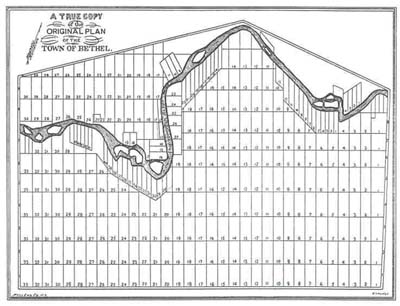 |
Arranged in a grid-like pattern, this "lot and range" plan of the late 1760s clearly shows the narrow forty-acre parcels of fertile "intervale" land near the Androscoggin River, which were much sought-after by Bethel's early settlers. Of this plan, one early town historian wrote, "The surveyors paid but little regard to the prescribed limits of six and three-quarter miles square. They extended their survey along the river in order to include all the good interval [sic] possible, for a distance of more than fifteen miles." |
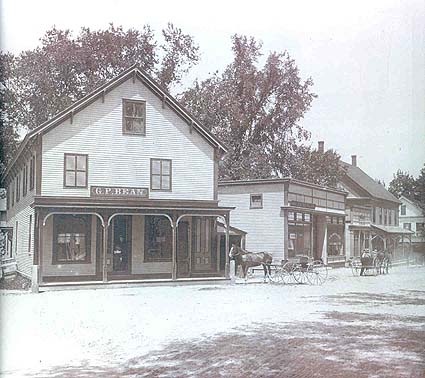 |
The commercial heart of nineteenth century Bethel was "Honest Corner," at the junction of Broad, Church, and Main streets in Bethel Hill village. Several structures shown in this circa 1885 photograph are still standing today. |
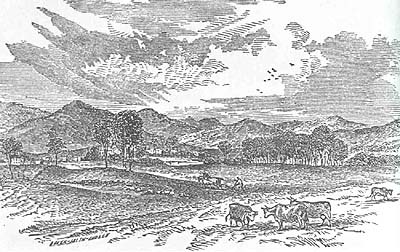 |
The town of Bethel is surrounded by some of northern New England's most dramatic mountain scenery, as evidenced by this engraving from the Guide Book of the Atlantic and St. Lawrence Railroad, published in 1853. Such artistic renderings greatly appealed to nineteenth century urban dwellers anxious to escape the oppressive heat and offensive smells of East Coast cities before the invention of air-conditioning. |
| Mind
and Spirit |
|
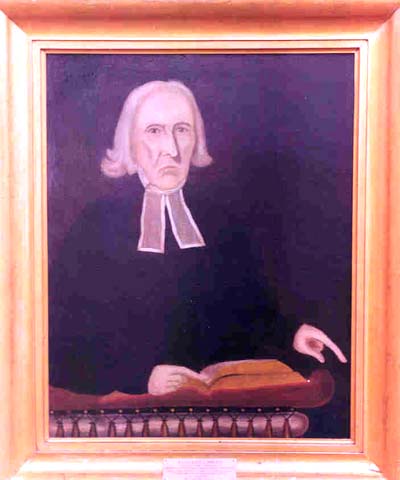 |
A graduate of Harvard, and perhaps the most learned man of Bethel in his day, the Reverend Daniel Gould was "of a rather worldly disposition, bringing the first chaise to Bethel, and wearing cocked hat, silk gown, and knee breeches around the town." The community's first-settled minister, Gould established a private school in his home that was the first secondary education offered in Bethel. The local Academy was named in his honor in 1843, a year after his death. Courtesy of Gould Academy. |
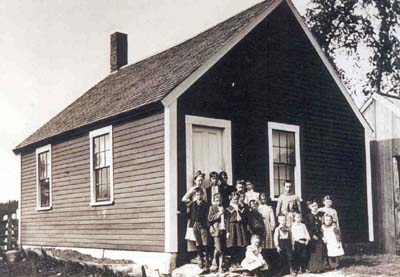 |
Modest, one-room district schoolhouses were at one time valuable centers of learning throughout small New England towns like Bethel. These forerunners of today's modern educational facilities provided a solid education under often less-than-ideal conditions. No longer standing, this school once occupied a spot next to the Flat Road Cemetery (just visible on the left) near the town's western border. |
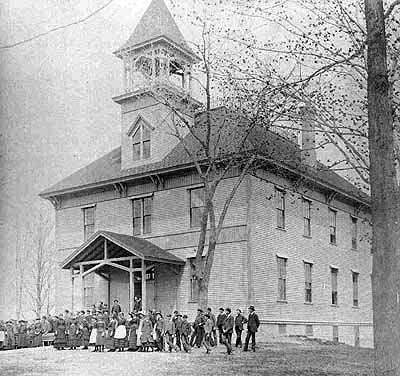 |
Students and teachers gather in front of the second Gould Academy building about 1890. Three such structures have occupied this same Church Street lot, including today's Hanscom Hall, a striking Colonial Revival edifice that opened in 1934. |
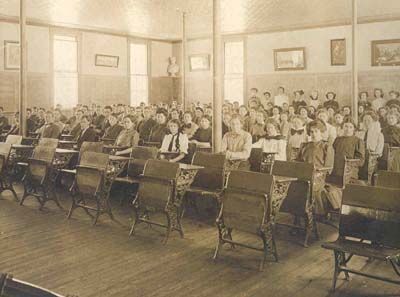 |
This late nineteenth century image provides a glimpse of the interior of Gould Academy's 1881 building (also shown above). Spacious and well lighted, the school's classrooms (and attic gymnasium) nevertheless contained wooden support columns that students and faculty found bothersome as the years passed. |
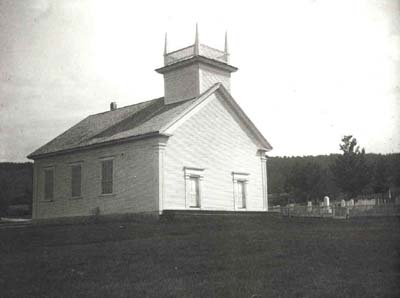 |
Bethel's oldest surviving religious structure, the Middle Intervale Meetinghouse was begun in 1816 and extensively remodeled in 1857. Once the site of early Bethel town meetings, as well as Methodist and Baptist church services, the building has witnessed numerous historic gatherings during its long existence. |
 |
One of the most important elements of town life in early Bethel was the church, and before 1820 Congregationalism remained the dominant religion, despite inroads made by the local Baptists and Methodists. The "Female Cent Society" of the West Parish Congregational Church, organized in 1815, raised funds "to assist in the distribution of the Scriptures" and "in supporting missionaries among the destitute." Like other early nineteenth century women's groups in northern New England, this local gathering also provided an important platform for the exchange of ideas and concerns of particular interest to Bethel's female population. |
 |
Gould
Academy's
transformation from the town's high school into a
private boarding school in 1968 marked the end of a significant era in
Bethel's history. That same fall, the newly completed "Telstar
Regional High School" opened on a Route 26 site a few miles south of
Bethel Hill village. |
| Getting
Around |
|
| Bethel's system of roads extended into every district of the town by the time this 1880 map was published in the Atlas of Oxford County, Maine. In 1843 a two-thousand acre area of Bethel (upper right hand corner of map) lying north of the Androscoggin River was joined with the settlement of "Howard's Gore" to create the town of Hanover. | |
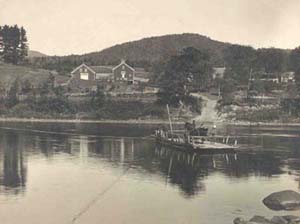 |
A half-dozen primitive but picturesque river ferries positioned along a fifteen-mile stretch of the Androscoggin once provided safe transport for Bethel's citizens. Shown here is the Bartlett/Bean ferry, which operated (utilizing the waterway's current to generate propulsion) from 1830 until 1910. |
 |
To prepare the way for a permanent and dependable crossing over the broad and often unpredictable waters of the Androscoggin River, a toll bridge company was organized by town vote in 1861. It was not until 1869, however, that this huge three-span, double-lane covered bridge between Mayville (a village on the north side of the river named for the profusion of Mayflowers found there) and Bethel Hill was opened to local traffic. Attributed to the drafting skills of Bethel architect Thomas Holt, the structure was demolished in 1927. |
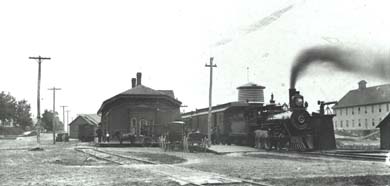 |
The
arrival of
the Atlantic and St. Lawrence Railroad in Bethel took
place on March 10, 1851. First proposed in 1844 by Andover native
John Alfred Poor as a way of boosting Portland's dwindling mercantile
trade and providing a winter link to the sea for Montreal to the north,
the railroad nonetheless brought great economic benefits to the dozens
of small New England towns scattered along the line. Built in
1865, Bethel's railroad station (left center) stood near the junction
of Main and Railroad streets until 1968. The Bethel Chair Company
mill, established in 1886, appears at far right. Courtesy of Arlan Jodrey. |
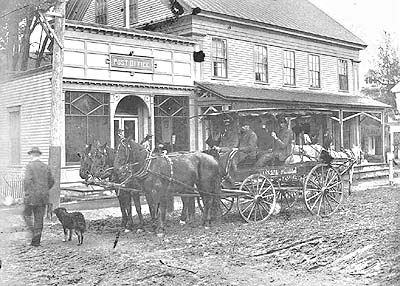 |
The Swift-Wiley Block on Main Street, with the Charles Davis stage in the foreground, circa 1896. Transporting "baggage, express, and mail matter," as well as passengers, this open coach (with canvas curtains that could be dropped during stormy weather) for many years covered the twenty-eight mile route from Bethel to the Lakeside House hotel on Umbagog Lake, near Upton. Davis's stage, and others like it, made daily connections with the morning train from Portland and the afternoon train to points east. Donald Brown Collection. |
 |
The
end of
passenger and mail service on the Grand Trunk Railway in
this region in 1960 caused the abandonment of many small stations along
the line. The conversion to more efficient diesel locomotives
also drastically reduced railroad employment all along the line.
The depot at West Bethel ("Allens") was razed in 1967. Donald
Brown Collection. |
 |
The twentieth century brought major developments to Bethel, beginning with the arrival of the first automobile in 1901. The popularity of the "horseless carriage" eventually transformed Bethel from a place of numerous shops where a wide range of products and services could be had, to one of fewer businesses of a more specialized nature. Bennett's Garage stood at West Bethel village until 1933. |
| All
in a Day's Work |
|
 |
The Colonial period settlement of Bethel began with the construction in 1774 by Joseph Twitchell of both a sawmill and gristmill at the foot of Mill Hill (Route 5). Necessities in the founding of most New England towns, these mills were the first framed structures erected in the town. This circa 1890 view shows the Eber Clough birch and stave mill, which later occupied the early sawmill site. Courtesy of Mary C. Keniston. |
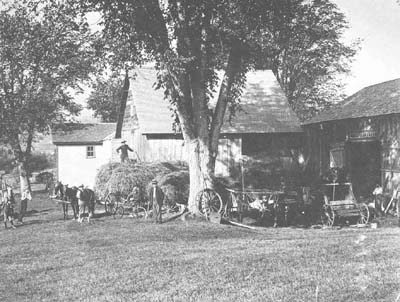 |
Bean's Corner village (East Bethel), circa 1900. Local photographer Irving Kimball captured this classic farm scene only a couple of decades after Bethel reached the peak of its agricultural production. In front of the "English barn" at right, two horses power a mechanism for threshing oats. |
 |
The largest commercial structure in Bethel for many years, the Kimball Block stood from 1865 to 1965 at Bethel Hill near the site of the town's new fire station. In the pre-automobile age, this community, and others like it throughout the Nation, provided a self-contained system of businesses wherein almost every necessity could be purchased locally. |
 |
Logging was an extremely difficult and dangerous task before the advent of mechanized transportation, but furnished a winter's occupation and supplementary income for many Bethel farmers. Stimulated by the development of papermaking facilities in several towns downriver of Bethel, log drives on the Androscoggin and its tributaries continued well into the twentieth century. |
 |
Women's work in eighteenth and nineteenth century Bethel was often tedious and backbreaking. Few today can imagine the difficulties faced in the never-ending routine of home life during this earlier time. |
 |
One of this community's largest nineteenth century industries was the Bethel Chair Company, established in 1886. The firm originally restricted itself to the production of Shaker-type rockers, but a variety of styles were eventually introduced. In 1902, Hiram Ricker (of Poland Spring fame) ordered three hundred chairs for one of his Maine hotels. |
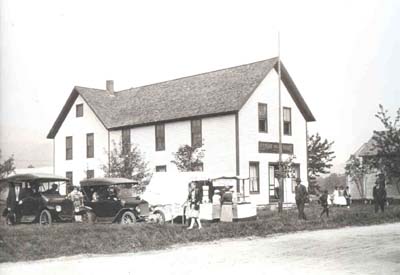 |
Following on the heels of the Farmer's Club movement, the Patrons of Husbandry (Grange) became highly popular throughout northern New England in the 1870s. Such organizations not only provided important social activities for isolated farm communities, but also promoted agricultural education and reform in a more structured manner than previously experienced. West Bethel's "Pleasant Valley Grange #136," shown here, was established in 1875 and still functions today. |
| A
Fashionable Retreat |
|
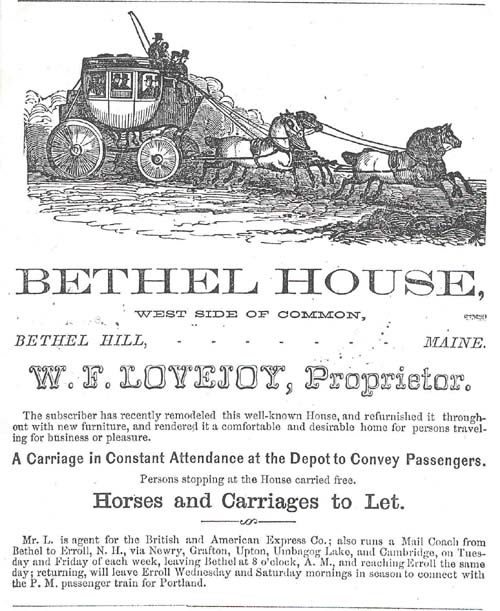 |
The Bethel House was constructed in 1833 as the first of several large wooden hotels facing onto the Bethel Hill Common. Even before the railroad's arrival in 1851, Bethel had established itself as a popular stopping-off place for travelers. |
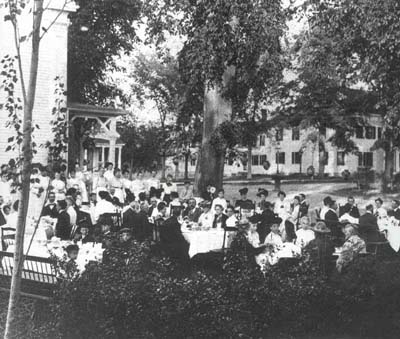 |
Bethel evolved into a much-favored inland watering spot for the well-to-do between the Civil War and World War I. In this circa 1900 photograph, a large group of elegantly-attired gentlemen and ladies prepare for a soiree on the lawn of "The Howard," at the north end of the Bethel Hill Common. The O'Neil Robinson House, now owned by the Bethel Historical Society, appears in the right background. |
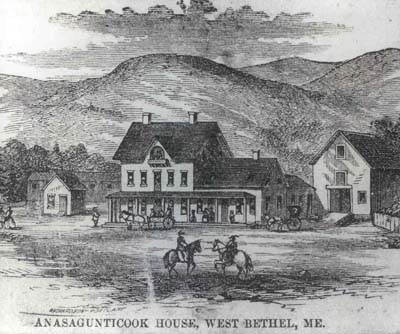 |
One of several medium-sized hotels that catered to the tourist trade in Bethel a century and a half ago, the Anasagunticook House was erected in 1859 by John S. Chapman on an elevated site opposite and a little downriver from West Bethel village. Active through the 1870s, the hotel boasted a chalybeate spring (one containing salts of iron) known widely for its restorative powers. |
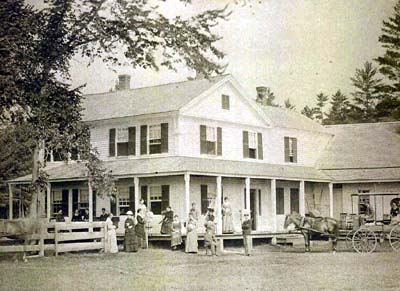 |
Long the home of the Valentine family, Spring Grove Farm on the North Road just west of Mayville furnished summer sojourners of the 1880s and 1890s with a quiet retreat that was only a few minutes ride by wagon from the Grand Trunk Railway station. Many of Bethel's visitors found the privacy and rural settings of such farms preferable to the village hotels then available. Courtesy of Mary E. Valentine. |
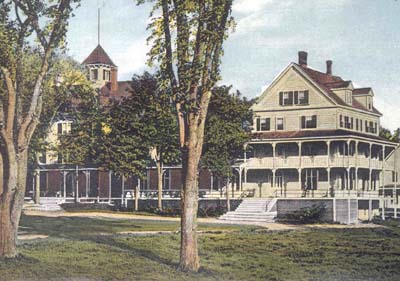 |
The Prospect Hotel was Bethel's largest nineteenth century hostelry. Begun in 1863, the hotel faced north from a site very near the present Bethel Inn. From its rooftop cupola, five stories above the ground, guests could take in an unobstructed view of the surrounding mountains. The building was largely destroyed by fire in 1911. |
 |
What may be the former Prospect Hotel "tally-ho coach" appears in front of the recently completed Bethel Inn around 1915. Once utilized to carry travelers throughout the hills of western Maine and northern New Hampshire, such conveyances lingered on as private hotel vehicles even after the automobile's appearance. Special occasions and outings, like that shown here, represented the final flourish of the stagecoach era in and around Bethel. |
| Celebrating
the Past |
|
 |
Long associated with the famous 1781 Indian Raid on Bethel and surrounding settlements, the Jonathan Clark House (which was actually built about 1785) was a much-venerated local landmark that finally succumbed to neglect in the 1920s. This ancient farmstead, set on a rocky hillside west of Bethel Hill, remained a favorite subject with photographers long after it became derelict. |
 |
Baptized by the French as "Marie Agathe"—a name that became "Mali Agit" when pronounced with difficulty by the Abenaki—Molly Ockett (the English version) is a legendary figure in Bethel's past. Though she died at Andover, Maine, in 1816, it was not until July 4, 1867, that a marker was placed over her grave. The dedication ceremony was highlighted by an address by Dr. Nathaniel Tuckerman True of Bethel, and a musical performance by the Bethel Brass Band. |
 |
Published on the one-hundredth anniversary of white settlement in Bethel, this small booklet contains a wealth of historical facts gathered by Dr. Nathaniel T. True, the town's beloved educator and historian. Bethel's major nineteenth century celebrations, of which this was the first, also included centennial events honoring the famous 1781 Indian Raid and the 1796 incorporation of Sudbury Canada as the "Town of Bethel." |
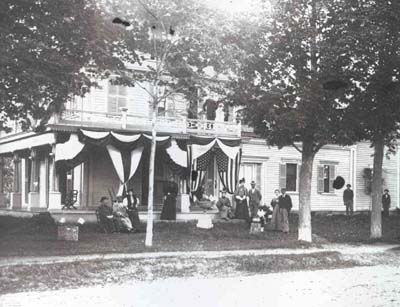 |
The Vernon Street home of General Clark S. Edwards was trimmed in patriotic bunting for the 1896 centenary of Bethel's incorporation as a town. Visible behind the porch roof balustrade, Edwards distinguished himself in several major Civil War engagements, including the Battle of Gettysburg. He ran unsuccessfully as the Democratic candidate for Governor of Maine in 1886 and was appointed Maine's Commissioner for the 1893 World's Columbian Exposition at Chicago. Donald Brown Collection. |
 |
The dedication in 1908 of Bethel's Civil War monument gave townspeople yet another opportunity to celebrate and commemorate the past. Fundraising efforts towards the purchase of such a memorial had begun as early as 1866. |
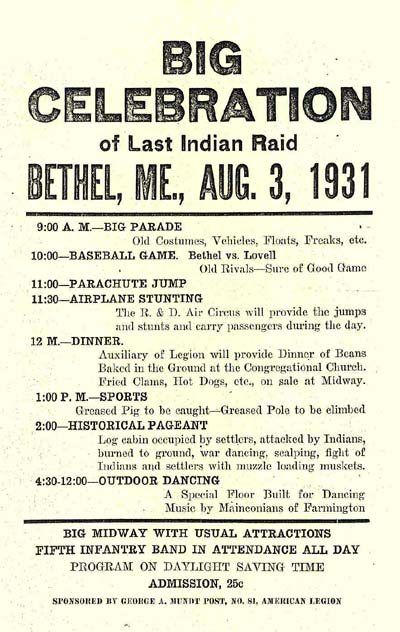 |
From the "antiquarian suppers" organized by Dr. Nathaniel Tuckerman True in the 1850s, to the Bethel Historical Society's creation in the 1960s, local citizens have acknowledged the past in a number of significant ways. The 150th anniversary of the Last Indian Raid in New England was celebrated in 1931 with one of the largest parades ever held in Bethel. |
